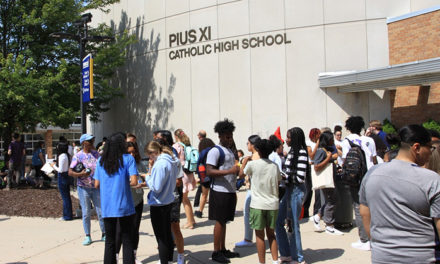Your child is not alone
By Candace Romano – Certified Grief Educator
 Back-to-school anxiety isn’t new, and anxiety in general is prevalent among Wisconsin high schoolers, suggests a state Department of Public Instruction (DPI) biennial student survey. According to the latest Wisconsin Youth Risk Behavior Survey, more than one in two students reported anxiety (52.2%), an increase from both 2019 (49%) and 2017 (39.9%).
Back-to-school anxiety isn’t new, and anxiety in general is prevalent among Wisconsin high schoolers, suggests a state Department of Public Instruction (DPI) biennial student survey. According to the latest Wisconsin Youth Risk Behavior Survey, more than one in two students reported anxiety (52.2%), an increase from both 2019 (49%) and 2017 (39.9%).
“We know that anxiety is a natural response when we have change, when we are excited, when we are going into the unknown,” said Jess Frain, a school mental health consultant with the state’s Department of Public Instruction. “Some of that is positive stress.”
Some young students may feel separation anxiety when leaving mom and the comforts of being home for the summer.
For those students in a transition year such as moving from middle to high school or going to a new school, anxiety can rear its head too.
For most kids the new school year worries will fade. But some students may become overwhelmed with stress and anxiety.
And clearly, Frain said, the pandemic created a layer of anxiety that hasn’t dissipated to this day. Some students still have apprehension about not seeing friends they grew to rely on or teachers that befriended them. “A lot of that was abruptly disrupted [by the pandemic]. It’s a level of trauma that’s waiting to be triggered.”
There are other stressors as well, she said. Students are well attuned to what goes on in the world, such as mass school shootings, and have heightened anxiety about that as well. “More than ever, students are connected to what’s going on in society.”
Some students take all that in stride, but Liz Krubsack, also a school mental health counselor with the DPI, advised parents and teachers to watch for signs that others may need some help adjusting.
One key to look for is a student who needs constant reassurance. If a child’s eating habits and sleeping routines have changes, and if they express fear about going to school, those issues should also be addressed.
Another signal: if a child avoids school or school-related activities. Frequent morning headaches and stomachaches – once cleared by a physician – and routinely being late may indicate the child is fearful to go to school.
“First, it’s important to just ask your student if they are feeling anxious,” she said. “Just being open and addressing that can be really helpful.”
Krubsack also suggests preparing your child for what will happen in school. If there’s an opportunity before classes start, let the student meet the teacher and get acquainted or re-acquainted with the school – the classrooms, lunchroom, gym.
What also helps? Start the back-to-school routine before school starts, such as reinstating a school-year bedtime and making sure the next day’s clothes are ready the night before.
 Regardless, a child’s anxiety should be taken seriously and not brushed-off with a “don’t worry about it, everything will work out.”
Regardless, a child’s anxiety should be taken seriously and not brushed-off with a “don’t worry about it, everything will work out.”
“It goes back to listening to your child,” said Frain. “Keep the line of communication open.”
She also said parents can help their children by modeling the behavior you want to see. It’s not to say parents don’t or can’t get anxious but watch how you react when you do and try to set an example for your child.
Finally, she said, “It’s OK to seek additional help.” A school counselor or social worker, or your primary physician, might be able to help you if you child’s anxiety is interfering with school and home life.
For more information contact:
Candace Romano
Certified Grief Educator
414-687-2196
candacedromano@gmail.com





